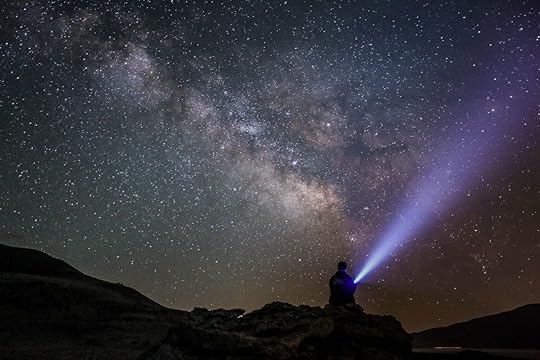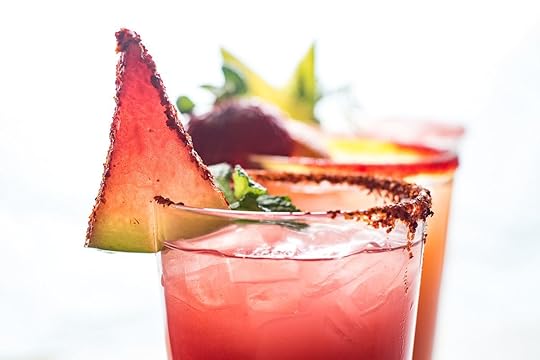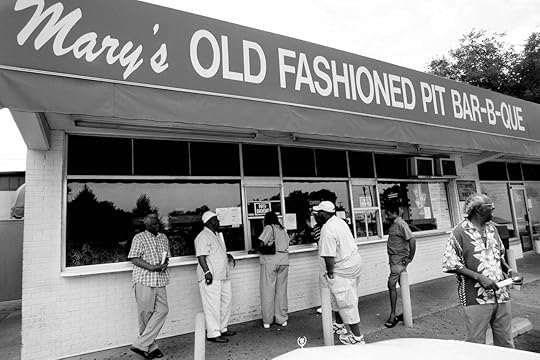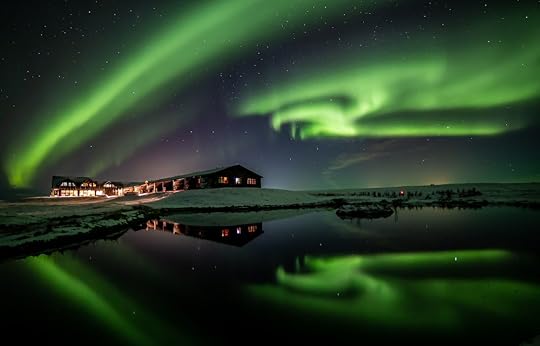Matador Network's Blog, page 620
July 27, 2021
Watch: This Olympic Rugby player shows off the perks of living in the Olympic Village on Tik Tok

There’s no doubt the life of an Olympic athlete is very busy, what with, you know, trying to win an Olympic gold medal and all. But some athletes are using Tik Tok to document their lives at the Olympic Village, including rugby player Cody Melphy competing for the United States.
Melphy’s Tik Tok of “things that just make sense” in the Olympic village has gone viral at 3.2 million likes. He shows off some perks like the giant dining hall that’s open 24/7 to feed some 10,000 athletes, autonomous buses to get around the village from their housing that’s separated by country, and free stuff like the Coca-Cola machine.
@codymelphyOlympic Village insider edition 👀 #tokyo2020 #olympics #teamusa #olympicvillage
Melphy also took a tour for viewers around the dining hall, which has two floors with tons of options. There’s a Japanese station, a pizza and pasta station, a salad bar and dessert station, and plenty more.
@codymelphyReply to @finnthewizard the food is 🔥 in the village #tokyoolympics #tokyo2020 #olympics #usarugby #teamusa #olympicvillage
Some viewers found out the athletes are sleeping on beds with cardboard frames. Melphy decided to put some rest to rumors that the beds are made out of cardboard to keep people from having sex. Even though he says the rumors are false, he did break his frame in the process so, careful Melphy.
@codymelphyReply to @thejorgeromero I broke the cardboard bed… #tokyoolympics #tokyo2020 #olympics
♬ Opportunity – Quvenzhané Wallis
Looks like the Olympic Village is even more fun than we thought it was. 
The post Watch: This Olympic Rugby player shows off the perks of living in the Olympic Village on Tik Tok appeared first on Matador Network.
Win a chance to see the best meteor shower of the year in a Dark Sky Sanctuary

Although the Perseid meteor shower has already begun, Reno Tahoe wants you to have the best view possible. You and a friend could win a two-night trip to Massacre Rim, one of the darkest places on the planet and a dedicated Dark Sky Sanctuary. This trip will be far from the light pollution of any major city, allowing you to catch the best view possible to spot some shooting stars — which, if you go August 12-13, you might see up to 100 meteors.
The prize package includes two domestic round-trip flights to the Reno-Tahoe International Airport, a 4-wheel drive rental car for two days to get you to and from the park, REI camping gear with a tent and two sleeping bags, a $200 gift card to a Reno Tahoe restaurant, a six-pack of assorted beers from local breweries to drink while you stargaze, and one night at a Reno Tahoe hotel before or after your camping adventure.
Entry is simple on the Reno Tahoe site. To qualify, you just need to be at least 21 years of age and have a valid driver’s license. The winner will be selected Friday, August 6, 2021. And although the best dates to go are August 12-13, this prize is redeemable until September 30, 2021.
The post Win a chance to see the best meteor shower of the year in a Dark Sky Sanctuary appeared first on Matador Network.
This desert oasis is the highlight of any trip to Tucson

Tucson’s population of 540,000 people is scattered across more than 200 square miles of sandy urban sprawl. If your goal is to hike or mountain bike the Santa Catalina Mountains, you’ll find it takes a bit of driving past fast-food joints and housing complexes to escape civilization. But keep heading north toward Oro Valley and on your way to the Catalinas you’ll find a delightful desert oasis tucked just off SR77, across the road from urban mainstays like Whole Foods and Starbucks. These sprawling, estate-like grounds are Tohono Chul Botanical Gardens and Galleries — a celebration of Sonoran Desert natural habitat, art, and culture.
Tohono Chul is a must-visit destination if you’re visiting Tucson, but before you imbibe one of the bistro’s famous prickly pear margaritas, there are a few things about the gardens you should know. Start your Tohono Chul visit by wandering the desert gardens and learning about the prickly pear cactus and its fruit — pink and purplish buttons that produce sweet, nearly neon-pink juice. They’re called tunas in Spanish and they’re in season in the summer through the fall months. A chilled prickly pear margarita is even more satisfying when you know a little bit about the colorful fruit — and after you’ve wandered the park in midday sun for an hour or so.

Photo: Cathryn Castle
The story of Tohono Chul starts in the mid-1960s when its benefactors, geologist Richard Wilson and his wife Jean bought the property where the gardens are now located. Developers came calling throughout the 1970s, but the Wilsons wouldn’t sell. According to Tohono Chul’s archives, Jean said of her decision, “I don’t want to sell the land. I don’t want it cemented over. I want to preserve it.”
The pair established the nonprofit Foundation for the Preservation of Natural Areas in the early 1980s. Historical documents preserved by Tohono Chul record Jean explaining the couple’s mission: “We wanted to keep something natural in the middle of all the (surrounding) development so that people could come easily for a few hours and get out of the traffic and learn something at the same time.”
Both Jean and Richard have since passed away, but the legacy they created is thriving.
Today the park is supported by donations and nominal entry fees. Volunteer docents are available to guide you, or you can grab a park map and enjoy your own adventure.
The words “tohono chul” mean “desert corner” and are from the language of the early Tohono O’odham people, hardy desert-dwellers renowned for their knowledge of Sonoran plants.
Today, the curated desert garden consists of 49 acres of trails and gardens that highlight the Arizona Upland subdivision of the Sonoran Desert — one of six distinct regions of North American desert and offering more varieties of trees, shrubs, cacti, and other succulent plants. Tohono’s collection consists mostly of plants native to the region or adapted to the American Southwest, including more than 150 species of shrubs and trees, 300 species of cacti and succulents, and 50 species of wildflowers.
The Santa Catalinas rising in the distance provide the perfect backdrop for the natural experience, although it’s important to note that Tohono’s location does more than provide a pleasant diversion for cityfolk. Wildlife have found a refuge within the gardens: Nearly 40 bird species make their permanent home here, and another 60 or so migrant species fly in and out seasonally. Other desert creatures often spotted here include jackrabbits, gila monsters and other lizards, bobcats, coyotes, and even gray foxes. Native tortoises even have their own preserve.
Just beyond the Sonoran Seasons Garden to the west is the Desert Palm Oasis, which is a careful recreation of a tropical forest found near the town of San Carlos, Mexico (six hours’ drive south of Tucson). Here, you’ll find towering tropical palm trees, including three species of fan palms. The oasis is a celebration of the Sonoran Desert’s diverse plant life.
What else to do at Tohono Chul
Photo: Nelson Sirlin/Shutterstock
In addition to natural beauty everywhere you look, the park features sculptural art created by local artists, and the entire park is set up as an educational center. The Geology Wall illustrates the geologic history of the Santa Catalina Mountains and the Saguaro Discovery Trail explains both the natural history and cultural significance of the towering cactus.
More adventurous visitors will enjoy walking the Hallowell Desert View Trail. It’s only about a half-mile long, featuring the desert in its natural state. Along the trail are two shaded ramadas with drinking fountains, but this trail is not wheelchair accessible.
The area known as Cholla Forest features “jumping” cactus that, although it doesn’t really jump, has an uncanny ability to attach to your clothing (or skin) if you happen to brush against it. The cholla cactus’ stems are covered in barbed spines. The stems detach easily, so do be careful not to get pin-cushioned. Although if you do brave the Cholla Forest, chances are you’ll see birds including the cactus wren and curve-billed thrashers — they love building their nests in the cholla. Also keep an eye out for Gambel’s quail, and the ubiquitous desert roadrunner.
Where to eat at Tohono Chul
Photo: Tohono Chul | Botanical Gardens & Galleries
Once your desert wandering is done, you’ll feel like you’ve earned a prickly pear margarita or two (there’s also a nonalcoholic prickly pear lemonade), or a local draft beer. The Tohono Chul Garden Bistro offers indoor, air-conditioned dining, or you can enjoy the outdoor dining area, adjacent to the Hummingbird Garden, which features a variety of plants attractive to hummingbirds. While the hummingbirds feast on the nectar of honeysuckle, agave, and salvia, you can satisfy your hunger with a classic burger and fries, brunch fare such as waffles or an omelet, or try one of the Bistro’s Sonoran-inspired dishes.
And guess what? The prickly pear margaritas are “bottomless” when ordered with an entree.
The hummingbird show and the slow-going Sonoran vibe at Tohono Chul invites you to stay a while longer. Summers are long here. Hiking and mountain biking can wait.
Where: 366 Paseo del Norte, Tucson, AZ 85704 
The post This desert oasis is the highlight of any trip to Tucson appeared first on Matador Network.
Go beyond hot chicken: 7 spots that show Nashville’s Black restaurant culture

Native Nashvillians often look at their city’s surge in growth, population, and popularity with a smirk and a side-eye. The bachelorette parties on Music Row, the parts of town that would never make a list of favorite neighborhoods, the dedicated sports fans — these and many other things didn’t exist a mere 15 years ago.
Another thing that Nashville wasn’t known for: its food. Food was the specialty of Memphis, Nashville’s sister city to the west. Named after a city on Egypt’s Nile River delta, Memphis has the state’s highest Black population at almost 65 percent, which adds to it being cemented on the barbecue and soul food map.
Yet while Memphis may be considered the hub of Tennessee’s connection to food, music, and civil rights legacy, Nashville also has notable ties to politics and music — plus the city’s Black food history runs deep.
Nashville is the capital of Tennessee and home to two prominent HBCUs. Food culture has always been an important part of the city’s connection to its Black residents. Civil rights leaders and politicians past and present have gathered around the tables of many of the city’s Black-owned restaurants since the early ‘50s.
With a plethora of restaurants that show both Nashville’s history and its bright future, visitors to the city should check out these spots to see how Nashville has more on its plate than hot chicken.
1. Swett’s RestaurantFamily-owned and operated for over 60 years, Swett’s has long been a major artery of Nashville food, and you get a peek into the city’s Black history walking through the doors. Swett’s has always had a diverse clientele, even when it opened in 1954. Known as a gathering place for not only locals, political leaders, college students, and celebs, but also travelers looking for real soul food from real Southerners, this cafeteria-style eatery is the spot.
Without frills or anything fancy, Swett’s takes a step back to a time when restaurants focused on the food and feeding their customers in a friendly and efficient manner. Thank yous and welcome backs are as plentiful as the food on display. While the decor is simple, Swett’s serves up some of the best mac and cheese, fried chicken, and peach cobbler you’ll have outside of somebody’s grandma’s kitchen. Pulled pork (a Tennessee favorite), beef tips, and country fried steak make Swett’s a must-visit pit stop anytime Nashville is on the itinerary. Vegetarians will swoon over the turnip greens, squash casserole, pinto beans, and yams — just a few of the “sides” that can turn into an entree. If you find yourself in Nashville, get familiar with the Southern “meat and three” dining tradition at Swett’s.
Where: 2725 Clifton Ave, Nashville, TN 37209, United States
2. Mary’s Old Fashioned Pit BBQ
Photo: Mary’s Old Fashioned Pit Bar-B-Que/Facebook
Located on Jefferson Street, the historic and beloved Black business district, Mary’s Old Fashioned Pit BBQ is a throwback to the lunch counter days. At Mary’s, you won’t find a large menu or a ton of different sauces, but you will find some of Nashville’s best food since 1962.
Many people confuse simple with basic, and good barbecue can be taken for granted when it’s treated simply. But Mary’s basics are exactly what barbeque is supposed to be. Hot sauce and coleslaw on pulled pork is the star of the show here. Rib tips, rib sandwiches, and cornbread fight for the leading role, though. Chicken and fried fish on white bread are also go-to inexpensive lunch options, but locals will rave about the smoked pork on cornbread pancakes.
While Nashville isn’t as known for its barbecue as Memphis, Mary’s has been, and will continue to be, a Nashville staple for decades to come.
Where: 1106 Jefferson St, Nashville, TN 37208, United States
3. Ed’s Fish HouseWhile Nashville is now known as the home of hot chicken, locals know the power of a good fish sandwich. Ed’s Fish House has been a Nashville staple since the early 70s and is still run by its namesake. The signature fish sandwich has become a secret that native Nashvillians would like to keep. Ed’s combination of whiting fish, pickles, American cheese, mustard, and hot sauce was not built for a fussy palate, but it appeals to those who know and love downhome comfort food. Adapting to the food truck trend, Ed now hosts his famous menu on wheels. Wings and catfish are also available, but Ed is the father of the Whiting Fish Sandwich, and this is exactly what you need to be eating when you visit his truck. Local college students flock to this inexpensive, but undeniably delicious, food and return to Ed’s during reunions and homecomings year after year.
Where: 2806 Smith Springs Rd, Nashville, TN 37217, United States
4. Slim & Husky’s
Photo: Slim & Husky’s Pizza Beeria/Facebook
Slim & Husky’s has quickly become a Nashville favorite due to its use of local vendors and selection of regional craft beers. The founders being Nashville natives — as well as graduates of Nashville’s Tennessee State University — is a key part of Slim & Husky’s success. The founders know the landscape of the city and are tapping into a food scene that has been overrun by non-locals taking advantage of Nashville’s growing tourism numbers. Slim & Husky’s dedication to the city puts Nashville in contention with some of the best pizza in the country. With pizzas such as “Got 5 On It,” “The Smokin Herb,” and the vegan-friendly “Nothin But A V Thang,” this restaurant gives everyone’s favorite food a very cool update.
Where: Multiple locations in the Nashville area, as well as Memphis, Atlanta, and Sacramento
5. EG & MCSituated on Historic Jefferson Street in north Nashville, EG & MC, a craft cocktail and tapas bar, is one of Nashville’s newest additions. The latest collaboration between Clint Gray, Derrick Moore, and EJ Reed — the hospitality group behind Slim & Husky’s Pizza Beeria — adds craft cocktail guru Gemaal Pratts of Aperitif to make EG & MC an elite Southern small plate and cocktail experience.
The name of the spot stands for Educated Gifted Melanated Creatives, and it’s reflective of the group’s collective personas.
“We take great pride in introducing a new, contemporary culinary concept to North Nashville, particularly along historic Jefferson Street, in the midst of not only a global pandemic, but also the community’s regentrification surge,” Gray says. “Through EG & MC, our goal is to offer guests a memorable experience while continuing our mission to pour back into the city’s urban core.”
EG & MC features Southern-inspired small plates such as a smoked meats and cabbage dish, which gives guests a choice between smoked short ribs, pork tenderloin, or turkey sausage alongside braised cabbage. Keeping with the Southern theme, other menu items include buttered hot water cornbread, a Nashville homecook favorite, accompanied by blackberry jam. A few signature cocktails include the classic, Southern Hospitality, as well as, The Gift + The Curse, a tasty blend of green apple juice and peanut butter washed rum.
Where: 924 Jefferson St, Nashville, TN 37208, United States
6. The Southern V
Photo: The Southern V/Facebook
While not widely publicized, there’s a growing Black Southern vegan population, as well as more people who have decided not to center every meal around meat. The Southern V is a family-owned and operated vegan and plant-based restaurant in the Buchanan Street Business District.
The restaurant is a huge hit with locals. It’s also great for visitors who follow a plant-based diet and often struggle when it comes to dining options in Southern destinations. Menu items include things such as the potato-based Meet Loaf, Loaded BBQ Jackfruit Nachos, Vegan Patty Melts, a number of vegan burgers and sandwiches, and breakfast items such as Chick’n and Waffles, Snausage Biscuit, and a delicious Veggie Scramble. A fan favorite is the Hot Chik’n Sandwich, which is a vegan version of Nashville’s famous hot chicken that allows vegan guests to enjoy a plant-based version of the city’s signature food.
Where: 1200 Buchanan St, Nashville, TN 37208, United States
7. Minerva AvenueLocated in the historic art district in North Nashville, this open-air lounge is a throwback to the ‘40s.
Minerva Avenue brings high-end mixology and yummy bites to a fabled, old neighborhood, and it gives a vintage speakeasy vibe with moody music and great conversation to a once forgotten area of Nashville. It’s a perfect spot for the weekday after-work crowd that may enjoy an end-of-day cigar, and Minerva also mixes up classic cocktail recipes to appeal to younger customers.
Locally loved, visitors to Nashville will find Minerva Avenue feels comfortable and much like home. The cocktails are why you come, though there’s also a small menu of mostly appetizers. Cocktails such as the ginny French 75, the Champagne-based Hangover, and a full shots menu are the perfect way to wind down under a Nashville sunset.
Where: 1002 Buchanan St, Nashville, TN 37208, United States 
The post Go beyond hot chicken: 7 spots that show Nashville’s Black restaurant culture appeared first on Matador Network.
Win a free month at this luxury hotel in Iceland if you shoot the northern lights

Hotel Rangá, a luxury hotel located on Iceland’s southern coast, just 90 minutes away from Reykjavík, is offering the gig of a lifetime.
The hotel is one of the few in Iceland to have a northern lights wake-up call for its guests, and now it’s pushing the aurora borealis perks even further.
It’s calling all aspiring photographers to come and stay for free for one month if they agree to capture photos and videos of the northern lights during their stay.

Photo: Kristján Pétur Vilhelmsson/Hotel Rangá
The job opportunity, titled “lights catcher,” will allow one lucky person to build up their portfolio by taking a trip to one of the most beautiful destinations in the world.
The gig will start mid-September and end mid-October, during which the “lights catcher” will be working the night shift, shooting the night sky to capture the impressive celestial phenomena.
In exchange for their high-quality images of the northern lights, the photographer will receive room and board at the hotel (including the hot tub and the access to the hotel’s stargazing observatory), free flights to and from Iceland, and access to the hotel’s sister property, Highland Center Hrauneyjar.
For more information and to apply, visit Hotel Rangá’s website. 
The post Win a free month at this luxury hotel in Iceland if you shoot the northern lights appeared first on Matador Network.
11 magical Airbnbs near the towering trees of Redwoods and Sequoia national parks

We hope you love the spaces and stays we recommend! Just so you know, Matador may collect a small commission from the links on this page if you decide to book a stay. Listed prices are accurate as of the time of publication.
See the tallest trees on Earth with a visit to California’s coastal redwoods in Sequoia and Redwood National Parks. The Golden State is the only place in the world where you can view groves of these ancient conifers, and it’s worth traversing the northern part of the state to see a variety of these giant trees. Instead of pitching a tent in a national park, stay nearby in private luxury at these California Airbnbs near Redwoods National Park for couples, friends, and families.
1. A rustic underground hobbit house built into the mountainside
Photo: Airbnb
Adventurous travelers who aren’t afraid of roughing it will love this underground hobbit hole for two. Located in a remote, off-grid eco-village in Del Norte County’s Smith River Canyon, the property is accessible via the scenic Redwood Highway (CA-199). While running water is available, electricity is not, but candlelit nights make for a romantic outdoorsy getaway. The common kitchen and bath are shared with the community, but you’ll have a private sleep sanctuary on the round love nest bed.
This rugged experience isn’t for everyone, as roads to reach the destination are winding and rough to navigate. But if you make the trip, you’ll love exploring the forest, streams, and waterfalls of the surrounding forested land. Unwind after a day outdoors in the wood-fired sauna, or hang with the chickens, goats, dogs, and woodland creatures that call this commune home.
Two guests, one bedroom
Price: $61 per night

Photo: Airbnb
Enjoy easy access to the beach and magical redwoods with a coastal stay in this 1968 Airstream trailer near Arcata, one of the most charming Airbnbs near Redwoods National Park. Quirky styling and modern comforts make this Globetrotter trailer a comfortable place to hang your hat, and the small but robust kitchen is great for fixing home-cooked meals. There’s WiFi if you’re working from home, and an outdoor deck to relax on when the sun goes down.
The trailer is permanently parked near sandy dunes and a beach — a 30-minute drive to Redwood National and State Parks. While tiny, this retreat includes a queen and twin bed plus a private bathroom and shower. You can even bring along Fido for a $25 pet fee.
Three guests, one bedroom
Price: $99 per night

Photo: Airbnb
Why just see the redwoods when you can sleep among them? Hunker down amid towering coastal redwoods at this tiny house built from salvaged redwood and upcycled materials. Just follow a winding path through ferns, huckleberries, and giant trees to reach this woodland hideaway. Take in the sunshine on the reclaimed redwood deck, or warm up inside around a cozy propane stove. Thoughtfully designed to maximize space, this little house includes a kitchen, bathroom, little living room, and comfortable bed in the sleeping loft. This forest sanctuary is located in Crescent City, the gateway to Redwoods National Park and three state parks that protect these old-growth trees.
Three guests, one bedroom
Price: $113 per night

Photo: Airbnb
Take in views of the Great Western Divide and famous Sequoia National Park sights from this cozy Mineral King Guesthouse located just four miles from the park’s main entrance. Set among oaks and manzanita, the quiet property welcomes human and horse guests (just in case you’re bringing Mr. Ed along). Big bay windows showcase garden and mountain views, or stroll around the property to see the horses and rescue pups that call this ranch home.
Two guests, one bedroom
Price: $185 per night

Photo: Airbnb
Treat your crew to a view at Sequoia Heights, a three-bedroom cabin that sleeps up to six. Located 10 minutes from the town of Three Rivers, the modern home is the perfect retreat after a day of redwood exploration in Sequoia National Park. This modern retreat is perched on a hill, and its second-story deck offers prime sunset vistas over the Main Fork of the Kaweah River. Airbnbs near Redwoods National Park rarely offer such a striking sky view.
Once night falls, stare up at the Big Dipper through the provided telescope. Or head inside to Netflix and chill, or jam out to tunes blasting from the home’s Bluetooth speaker. If you’re “working from home” during your vacay, this cabin’s free WiFi is helpful since cell service is sparse. Little bonuses like included coffee, spices, and condiments make cooking for your crew a cinch. Brand new washer and dryer available if you need to launder clothes dirty from tromping through woods and waterfalls.
Four guests, two bedrooms
Price: $263

Photo: Airbnb
Bringing a crowd to Sequoia National Park? You’ll love this recently renovated riverfront home for groups of up to eight people. Take in nature through glass walls overlooking the Kaweah River, or enjoy dinner with your group on the breezeway around a table made from a local redwood tree. Splash or fish in the river when the weather is warm, or play a round of volleyball at the net set up along the water. Enjoy s’mores and storytelling around the fire pit when the sun goes down. The four-bedroom three-bathroom space offers privacy and upgraded everything: new flooring, heating, cooling, beds, and accessories.
Eight guests, four bedrooms
Price: $415 per night

Photo: Airbnb
Bring Rover along to Sequoia National Park for a stay at this dog-friendly space just three miles from the park entrance. It’s set amid oak trees with a fenced-in yard where your doggo can play worry-free. Note: dogs are not allowed on park trails, but you can leave your pup behind while you play in the park. Or the host can point you to dog-friendly trails beyond Sequoia. Take a break from outdoor exploration and walk to the quirky town of Three Rivers to visit breweries, coffee shops, and stores. The guest suite includes a plush bed, fridge and freezer, microwave, toaster, coffee bar, and private bathroom.
Two guests, one bedroom
Price: $133 per night

Photo: Airbnb
Stay in the heart of the California redwoods, just a mile from the ocean, at this creekside retreat in the town of Orick. Expect comfortable temperatures, fresh air, and beautiful beaches near this six-acre property nestled between mountain peaks and towering trees. After a day of adventuring, relax in the Jacuzzi bathtub, sweat in the sauna, or simply roast s’mores around the outdoor fire pit. Inside the home, gather your group in the modern kitchen and dining areas, or find privacy in three private bedrooms that sleep eight.
Eight guests, three bedrooms
Price: $232 per night

Photo: Airbnb
Live the ranch life along the river at this spectacular river ranch cabin fit for two couples or families. Reachable only by a dirt road, Sequoia National Park’s gigantic trees are just 15 minutes away, but you can also go waterfall hiking, swimming, and boating on the ranch’s 380-acre property. Guests also get access to a mile of Kaweah River frontage for swimming and fishing. The private cabin has a full kitchen for dinners in, laundry machines for washing grubby clothing, and peaceful disconnection from the outside world.
Four guests, one bedroom
Price: $219 per night

Photo: Airbnb
Spend a night in this cozy cottage nestled on four-and-a-half acres of beautiful second-growth redwoods outside the town of Trinidad. It’s a small and simple cottage with three beds and everything you need to cook meals. There’s no TV, but WiFi is available if you’re WFH. Instead of sitting inside, explore outdoors on the property’s trails along the creek, grill on the barbecue, or just roast s’mores around the fire pit. Perfect for a family as it features a sleeping loft with a queen-size bed and a pull-out Murphy bed.
Five guests, one bedroom
Price: $156 per night

Photo: Airbnb
Experience modern luxury for your group at this luxurious redwood retreat that sleeps seven. Located two miles from the town of Trinidad and 20 minutes from Redwood National Park, it’s an excellent family basecamp for recharging after a day spent exploring outdoors. Relax your muscles post-redwood hike with a soak in the hot tub, or burn off extra energy shooting hoops on the basketball court. Inside the home is filled with books, a piano, and three TVs to keep everyone entertained. If you’ll be venturing onto the water during your stay, there’s even parking for a boat. Parents can rest their heads in a private master bedroom with ocean views while kids have a sleepover in a room full of trundle and twin beds. 
Seven guests, three bedrooms
Price: $450 per night
The post 11 magical Airbnbs near the towering trees of Redwoods and Sequoia national parks appeared first on Matador Network.
The top hotels for extravagant floating breakfasts and how much they cost

Floating breakfasts are the picnic lunch of the influencer era. By most practical metrics, they make very little sense. While a picnic requires you to sit uncomfortably cross-legged on the ground while swatting bugs away from your food (which hopefully isn’t blowing away in the wind), floating breakfasts take the inconvenience to a new level. Now offered by many luxury hotels around the world — most notably in Bali and Maldives — floating breakfasts have become hugely popular for their Instagrammable aesthetic, but add a watery question mark into the mix as well. What if someone cannonballs into the pool and your breakfast capsizes? What if you splash pool water onto your eggs? Influencers and luxury travelers don’t seem to care. The decadent optics of consuming fruit and toast in an infinity pool is simply too tempting to ask questions. They might not be the most practical, but they’re certainly among the most visually pleasing breakfast experiences. From Italy to Bali, these are the hotels known for their extravagant floating breakfasts and how much they cost.
1. The Four Seasons, Maldives
Photo: Four Seasons Maldives
The Maldives are known for their ritzy experiences curated to look as appealing as possible on the ‘gram. It makes sense, then, that one of the Maldives’ most luxurious hotels also has one of the most widely known and coveted floating breakfasts. The floating breakfast at Four Seasons Maldives comes highly recommended by Wendy, a photographer and creative director who has traveled to hotels all over the world.
“Imagine waking up in your villa and having a beautiful floating breakfast waiting in your private pool outside,” she says. “Their menu includes everything from a Maldivian sampler to fresh baked goods, eggs, waffles, freshly squeezed orange juice, mimosas and a tropical fruit plate.”
Indeed, the breakfast arrives in your pool on a designed tray full of Continental breakfast goods, including a bakery basket with a croissant, pain au chocolat, bread, toast, Danish pastries, roll and bagel. There’s also a selection of sliced tropical fruits, juices, marmalades, and of course, Mimosas. There’s also the option to order Floating Sundowners, if you’d prefer to take another meal in the pool besides breakfast.
Price: $65 per person
2. Chalet al Foss, Italy
Photo: Hotel Chalet al Foss and Hotel Chalet al Foss/Facebook
Floating breakfasts might immediately conjure images of paradisiacal islands, but they’ve made their way to some of Europe’s luxury hotels, too. Chalet al Foss, located in the Italian Alps, offers a floating breakfast rivaling anything you’ll find on an island vacation. Served in an infinity pool with a view of the surrounding Alps, the floating breakfast is available by prior reservation only for hour-long blocks. You must contact the hotel concierge to confirm availability.
The hotel also offers a unique “Foss Breakfast” in the winter, which is pretty much the complete opposite of the floating breakfast. The Foss Breakfast is served on a heated bed tucked into a snowbank for a wintry breakfast in bed.
Price: $153 for two people
Foss Breakfast Price: $130 for two people

Photo: Tanah Gajah, a Resort by Hadiprana
Many of the world’s most decadent floating breakfasts can be found on the small Indonesian island of Bali, popular among vacationers and digital nomads for its beauty and affordability. At the Tanah Gajah resort in Ubud, visitors can enjoy a floating breakfast either in the main swimming pool or in your personal villa’s private pool, with goodies like fruit, eggs, coffee, tea, bread, and champagne served up on a wooden tray.
Price: $58 per couple for a floating breakfast, or $102 per couple for a floating breakfast with sparkling wine
4. Monte-Carlo Bay, Monaco
Photo: Monte-Carlo SBM/Facebook
Monaco is defined by its extravagance. Supercars zoom through the streets, billion-dollar yachts sit in the harbor, and scrambled eggs float on the water as if by magic. Ok, it’s not magic, it’s just one of Monte-Carlo Bay’s more extravagant offerings. The floating breakfast at this Monaco hotel allows guests to start their day in the sandy bottom lagoon, which winds between the hotel terraces and green islets. The floating tray comes fully stocked with bread and pastries, cheeses, cured meats, cereals, yogurt, juice, Veuve Clicquot champagne, fruit skewers, crêpes, hot dishes a la carte, a cooling towel, and your choice of newspapers. You must book 24 hours in advance to reserve the experience.
Price: $153 per person for hotel guests, $94 surcharge for additional non-overnight guests
5. Hurawalhi Resort, Maldives
Photo: Hurawalhi Maldives and Hurawalhi Maldives/Facebook
This is the Maldives’ second appearance on this list, and it’s well-deserved. The Hurawalhi Hotel offers a Floating Champagne Breakfast, which has quickly become a favorite among frequent travelers and influencers looking for a photo-ready culinary experience.
According to frequent traveler and digital nomad Olivia Living, the floating breakfast here is the best she’s ever had.
“While I initially presumed my seven-course dinner at the resort’s 5.8 Undersea Restaurant would be my most Instagrammable meal at Hurawalhi Resort,” she says, “I retracted that statement the following day. The intimate floating breakfast in the privacy of my pool villa took the cake (literally). Surrounded by a kaleidoscope of blues, I toasted with Taittinger Brut Champagne, consumed courgette and smoked salmon fritters with avocado salsa, and finished with a banana cake. What elevated this particular floating breakfast from others I’ve experienced was that I shared it with curious ocean critters below: nurse sharks, clownfish, and even a Hawksbill turtle.”
The hotel even describes the breakfast on its website as one with “envious photo opportunities.”
Price: $240 per couple
More like thisWhere to Stay7 desert hotels where you can truly get away from it allThe post The top hotels for extravagant floating breakfasts and how much they cost appeared first on Matador Network.
7 reasons to see Alaska THIS summer

For much of the summer, the sun barely sets on Alaska. That means there’s that much more time to revel in the state’s bigger-than-life landscapes, spot wildlife from birds to bears, jump between urban centers and pint-sized communities, sample the freshest seafood, and explore new, truly stunning locales.
Those long days can help you make up for some of the lost travel opportunities from the last year, too. In fact, Alaska checks a lot of boxes for travel in these uncertain times: It has vast landscapes where you might not see another person for hours; it’s likely different enough from where you call home that it feels like a true escape; and most importantly, it’s open right now. So while taking a trip to Alaska is a great idea any year, here are a few simple reasons why you should visit this summer.
1. Alaska’s natural areas are open to visitors. Wide open.
Photo: Galyna Andrushko/Shutterstock
Nature is one of Alaska’s supreme attractions. And considering this is the largest state — bigger than Texas, California, and Montana combined — it’s hard to talk about the breadth of Alaska’s outdoors without using superlatives.
So, get this: The state has Denali (meaning “The Great One” in Koyukon-Athabascan), the highest peak in North America at 20,310 feet, as well as 17 of the 20 highest mountains in the US. It claims more than half the world’s glaciers, topping out at more than 100,000. The four largest US national parks — including the 13.2 million-acre Wrangell-St. Elias National Park, which is larger than the five smallest states put together — are found here. And there are roughly 34,000 miles of shoreline, aka more than the other 49 states’ combined. This means habitat for millions of shorebirds and marine wildlife literally surrounds the state!
All this to say, if you’ve been feeling pent-up and are looking for fresh air, open spaces, and some serious nature exploration, you’re in the right place.
2. This year, Alaska’s cruise towns are seeing fewer visitors.
Photo: Joan Vadell/Shutterstock
During “normal” summers, Southeast Alaska communities — Ketchikan, Sitka, Juneau, Skagway — are popular stops for cruise-ship visitors. But due to fewer large ships setting sail in 2021, Inside Passage towns are currently quieter.
And these communities pack in outsized fun, quiet or otherwise. Check out the lasting Russian influence and wander the Tlingit and Haida totems in Sitka; go brewery and distillery-hopping in Juneau, or don crampons for a trek on Mendenhall Glacier; learn the history of the one-time “Canned Salmon Capital of the World” in Ketchikan; and dive into Skagway and its gold-rush past. When you’re ready to move on, hop aboard one of the frequent ferries or book a flight to your next adventure on Alaska Airlines or another regional, in-state, or charter air service.
3. You’ll have as many wildlife encounters as human encounters.
Photo: Santiparp Wattanaporn/Shutterstock
From massive brown bears snagging salmon out of a rushing stream to gravity-defying whales breaching off the side of your boat, there’s never a shortage of incredible animal encounters in the 49th state, no matter when or where you visit. And though it’s entirely possible to spontaneously see moose, bears, eagles, puffins, wild sheep, salmon, and whales while you’re exploring Alaska, many businesses can help increase your odds:
Flightseeing companies run excursions to Katmai National Park and Preserve, where over 2,000 brown bears roam.Reindeer ranches and farms in Fairbanks and Palmer offer close-ups with these cousins of caribou.Day cruises can give you glimpses of orcas, humpback and gray whales, sea otters, sea lions, and massive sea bird rookeries.The Alaska Wildlife Conservation Center near Girdwood at the start of the Kenai Peninsula and the Alaska SeaLife Center in the coastal town of Seward facilitate exceptionally educational encounters with the state’s various land and sea creatures.4. There’s exploration for everyone.
Photo: AlaskaDad/Shutterstock
Most experiences in Alaska have a maximum and a minimum when it comes to skill level and stamina. So no matter how much energy — and time — you have to burn, there’s likely an option that works for you and your group.
Those seeking something more relaxed can opt to stroll one of the state’s myriad well-maintained walking trails with a coffee in hand, bike along an urban greenway, hop aboard a wildlife-watching cruise or one of Alaska’s marine ferries, or maybe kick back on a scenic train ride. On the other hand, if you’re looking for a more extreme foray into Alaska’s landscapes, you can trek along moraine-marked glaciers, ride in a helicopter to the summit of little-touched peaks and mountain bike down, kayak between floating glacial ice, or pack-raft through striking river canyons. Bring the kids, bring the grandparents — Alaska is an all-family affair.
5. The food doesn’t get any fresher.
Photo: CSNafzger/Shutterstock
Salmon and halibut and king crab, oh my! If you’re a seafood lover, Alaska is the right place for your taste buds. In much of the state — but particularly in coastal cities — restaurants boast menus with locally sourced salmon, halibut, rockfish, crab, shrimp, and oysters that are wildly dissimilar to what you can get back home, both in terms of quality and freshness.
Also, it doesn’t get fresher than catching it yourself. Throughout the state, guide companies take guests out to fish for halibut, cod, rockfish, and salmon off the coast, as well as trout and salmon in freshwater rivers and lakes. The captains have the gear and the local knowledge of dependable fishing spots that’ll help inspire your “It was thiiis big!” stories for years to come.
6. You’ll experience an entirely different American culture.
Photo: CREATISTA/Shutterstock
Roughly 20% of Alaska’s population is Indigenous, and the cultures of the 229 Federally Recognized Tribes can be seen statewide through languages, traditions, art, and more. Here are some ideas for your trip:
In Anchorage, stop by the Alaska Native Heritage Center or the Anchorage Museum to explore exhibits that encompass over 10,000 years of history.Up at the tippy-top of the state in Utqiaġvik (previously known as Barrow), visit the Iñupiat Heritage Center to witness cultural revitalization efforts and learn about this Arctic community’s hard-earned whaling legacy.Down in Kodiak, in Southwest Alaska, scope out 7,500 years of Alutiiq heritage at the Alutiiq Museum & Archaeological Repository.In Sitka, peek inside the Sheldon Jackson Museum to see traditional regalia, and then walk through the Sitka National Historical Park and among its dozens of traditional totems.7. Making the trip is so much easier than you think.
Photo: Martina Birnbaum/Shutterstock
We get it — the breadth of activities and the vast size of the state can be intimidating. But taking a trip to Alaska is easier than you might imagine, and it’s common for first-time visitors to comment how approachable it feels when you’re here — you quickly feel like you belong.
Even with travel ramping up, flights to Alaska are competitively priced and several airlines operate additional summer routes, making getting there even easier. The capital city of Juneau is just 2.5 hours from Seattle by air, while there are direct flights to Anchorage from many major cities, including San Francisco (4.5 hours), Denver (5 hours), Los Angeles (5.5 hours), Chicago (6.5 hours), and New York City (7.5 hours). And while you can plan everything yourself, you don’t have to. There are countless businesses — from small-vessel cruises to all-inclusive lodges to organized tours — that can customize your trip to make your grandest Alaska dreams a reality. This summer. 
The post 7 reasons to take your dream Alaska trip THIS SUMMER appeared first on Matador Network.
July 26, 2021
This little-known program lets you eat for free at many airport restaurants

Airport food is undeniably expensive. Whether you’re hungry in between layovers or you’re going to be stuck on a flight with bad airplane food, it’s typical to bite the bullet and just pay the astronomical pricing for some chicken tenders and fries. But we’ve got a major travel hack to let you in on — if you join Priority Pass, you can skip all of that and get those expensive meals for free.
Many travel credit cards offer a free Priority Pass airport lounge membership, which gets you access to over 1,300 lounges. Once you join, the dilemma of whether or not to shell out to eat at the airport becomes a thing of the past. Priority Pass lounges typically offer free drinks and lots of snacks, which should fill you up before reaching your destination. However, even if the airport you’re at doesn’t have a lounge that is a member of the Priority Pass program, you are eligible for $56 off your meal — $28 for you and $28 for a friend — at many airports around the United States and beyond.
You’re going to need a card like the Chase Sapphire Reserve or the U.S. Bank Altitude Reserve Visa Infinite® Card to participate. Note that American Express cards that offer Priority Pass do not offer this deal. Once you have the card in your possession, sign up for the complimentary Priority Pass program through its website. Then, through this little-known travel hack, your bill at over 50 participating restaurants with locations in many large US airports will receive a major discount. Download the Priority Pass app and sign in with your account for airport maps and info on participating locations. Then, all you have to do is show up, place your order, and swipe your Priority Pass membership for the discount.
If you want to take advantage of this discount, however, you’re going to need to be comfortable making your way around to different terminals, as the restaurant you want (or the closest one that’s a member of the Priority Pass program) could be on the other side of the airport. You could also take advantage of this deal by popping around to several restaurants, getting $28 off per meal, with every swipe. Just be sure to tip for the original meal cost. Don’t cheat your server just because you got a discount. 
The post This little-known program lets you eat for free at many airport restaurants appeared first on Matador Network.
50% of Canadians live south of this line

Canadians have been amping up their hardcore ruggedness and tough skin for a few centuries, but the jig is up. The Great White North, as it likes to be called, is actually mostly empty of people because 50 percent of Canadians live in a tiny section of the provinces of Ontario and Québec that includes Toronto, Ottawa, and Montréal.
Youtube channel RealLifeLore tells it like it is, and explains that while most Canadians like to say they live much farther north than most Americans, it isn’t exactly true. About 70 percent of all Canadians live south of the 49th Parallel, the imaginary line that forms most of the border between Canada and the US. Even more upsetting for the Canucks’ image — most Canadians live farther south than all the people who live in Washington, Montana, North Dakota, and, of course, Alaska.
The final nail in Canada’s reputation is the fact that more Americans live north of Canada’s most southern point, i.e. Middle Island, than Canadians. How’s that for a reality check, eh?
Of course, there’s a very good reason for this population repartition: The climate. Most of Canada’s weather is extremely cold and snowy in winter, making for a very difficult lifestyle. According to RealLifeLore, the region that encompasses the cities of Windsor, Toronto, Ottawa, Montréal, and Québec City has richer and deeper soil than anywhere else in the country, allowing for the agriculture needed to feed the population.
But the weather and soil are not the only factors pushing Canadians to huddle around the Great Lakes. Geopolitical and geoeconomic reasons have led many Canadians to live near the long, strategic, and beautiful St Lawrence River.
RealLifeLore’s video has more about Canada’s population distribution. Remember these facts next winter when Canadians try to make you believe they’re tougher than you are. 
The post 50% of Canadians live south of this line appeared first on Matador Network.
Matador Network's Blog
- Matador Network's profile
- 6 followers



